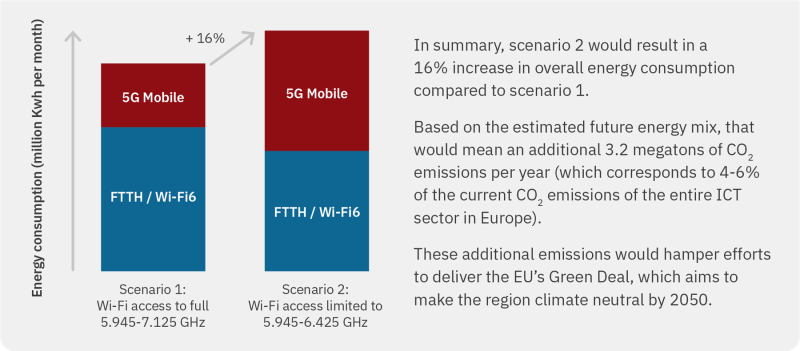The Wi-Fi Alliance (WFA) wants to make sure policymakers at the upcoming 2023 World Radiocommunication Conference (WRC) know how much Wi-Fi contributes when it comes to environmental sustainability.
It’s especially germane when it comes to Europe. The European Union has opened the lower portion of the 6 GHz band (5.945-6.425 GHz) to Wi-Fi, but the upper portion of the band remains in play.
At the upcoming WRC that starts in November, policymakers will debate designation of the upper 6 GHz band for licensed mobile deployments, i.e., 5G or International Mobile Telecommunications (IMT). The Wi-Fi Alliance says identifying the upper part of the 6 GHz band for 5G/IMT would be at the expense of Wi-Fi – and detrimental to efforts to improve the environment.
This week the WFA highlighted a WIK-Consult report that shows how allowing Wi-Fi access to the entire 6 GHz band advances environmental sustainability goals in combating climate change.
The 56-page report estimates that if there’s insufficient spectrum available for Wi-Fi, 15% of data traffic would shift from fiber-to-the-home (FTTH)/Wi-Fi networks to 5G mobile networks. That shift would lead to around 16% more energy consumption, which translates to 3.2 megatons of additional CO2 emissions in Europe per year.

“That's what we wanted to point out to Europe,” said Alex Roytblat, VP of Worldwide Regulatory Affairs at WFA based in Washington, D.C. “Most of the policymakers that I hear are so committed to environmental sustainability,” with efforts like the Paris Agreement on climate action. “But when we go to spectrum policy, that somehow is not carried through by some policymakers in Europe or elsewhere. We think that this report may be informative to them to kind of reconsider some of their positions as they go into WRC.”
The differences between cellular and Wi-Fi signals are well documented. Cellular signals need to blast through walls and windows to get to the devices inside buildings; similarly, the devices need to send signals back through walls and propagate a sizable distance to get to the base station. “That is an extremely energy-inefficient model. It wastes a lot of power,” Roytblat told Fierce.
By contrast, in a Wi-Fi scenario, the signal is in immediate proximity of the user. “The Wi-Fi model for delivering data where it is needed most, which is indoors, is a much more energy efficient model than the wide area cellular model,” he said
6 GHz in the U.S.
The WFA would like more countries to emulate the U.S. when it comes to 6 GHz spectrum for unlicensed usage. In 2020, the FCC adopted rules to make 1,200 megahertz of spectrum in the 6 GHz band (5.925-7.125 GHz) available for unlicensed use. Unlicensed devices share the spectrum with incumbent licensed services, like microwave services that are used to support utilities and wireless backhaul.
The FCC authorized indoor low-power operations over the full 1,200 megahertz, while standard-power devices are allowed to use 850 megahertz in the 6 GHz band. An automated frequency coordination (AFC) system is being developed to prevent standard power access points from operating where they could cause interference to the incumbents.
So far, the FCC has conditionally approved about 12 entities that are now gearing up for the AFC testing phase. How many of them eventually will pass the testing phase and move into commercial operation remains to be seen.
